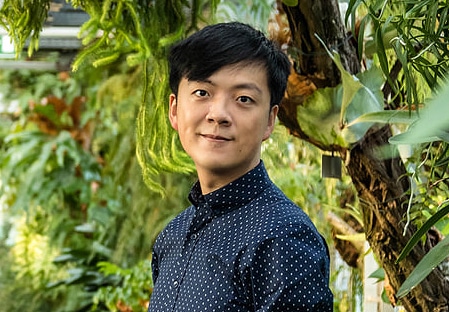Should I buy a real or a fake Christmas tree?
Wednesday 16th Dec 2020, 11.48am
It’s that time of year – the festive jumpers are going on, the lights are going up, and we’re ready to decorate our Christmas trees. But when it comes to choosing your fir, what do you go for – real or fake? Perhaps you have a trusty old family-favourite that comes down from the attic each year? Or maybe going to choose a real tree gets you into the festive spirit? Either way, have you ever wondered which is best for the environment? In this episode of the Oxford Sparks Big Questions Podcast, we’re chatting to forest scientist Henry Hung about which trees are the greenest (not literally!).
Emily Elias: Christmas is upon us and if you are anything like me, you have got an imaginary David Attenborough over your shoulder telling you not to be wasteful. But it has been a rough year and sometimes you just really want a Christmas tree to make it all better.
On this episode of the Oxford Sparks Big Questions podcast we are consulting the professionals and we are asking, “Should I buy a real or a fake Christmas tree?”
Ho ho ho. I’m Emily Elias and I promise I am not here to ruin Christmas for you, but you are listening to the podcast where we find really smart people at the University of Oxford and we ask them the big questions. For this one I’ve managed to find a researcher who loves trees and is willing to indulge my festive spirit.
Henry Hung: I’m Henry Hung from the Department of Plant Sciences at the University of Oxford. Actually, my research is not so much doing [sic] with Christmas trees but I’m actually looking at some tropical forests in South Asia and conserving this really valuable timber tree called ‘rosewood.’ I mingle with forest scientists. I’m in a forest research group so I do hear a lot about these conifers, these amazing Christmas trees.
Emily: You are technically not a Christmas tree academic but you are willing to fill in some of the gaps for us on this big, big debate?
Henry: Well, I can say I’m a Christmas tree enthusiast.
Emily: Christmas tree enthusiast, perfect, okay. Do we know, on average here in the UK, how many trees are sold every year?
Henry: Oh, it is a hard estimate but I think the British Christmas Tree Growers Association, this year they estimate around 7m to 8m Christmas trees bought each year. I mean real trees.
Emily: How long does it take to grow one?
Henry: I would say around 10 years to grow to a marketable size like 7ft height, something like this. It takes around 10 years. Well, it varies between different species. For example, actually the most popular Christmas tree in the UK is called the ‘Nordmann fir,’ which originates from Turkey, Georgia, Russia, like that side of Europe.
They are very popular because the needles are not sharp and they don’t drop readily indoors, so making them very low maintenance, really cool and they also roughly take around 10 years to be a marketable size that you can put at home.
Emily: Obviously, a lot of work has gone into making the perfect cone-shaped Christmas tree. I mean, what is the carbon footprint on this from start to finish?
Henry: Actually, it really depends on how you handle the tree as well. We often think about these as a lifecycle or what we call in environmental science the ‘cradle to grave,’ which literally means where it finally ends, where its destiny is.
One thing to think about is once we’ve got the Christmas tree at home and after Christmas, what do we do with that Christmas tree? One, actually, big problem is the disposal part.
If we say, “Oh, I got a really good environmentally-friendly Christmas tree from the local source, but if I dispose them in the landfill, actually it is a big problem,” because landfill leachates have these little, tiny, tiny, teeny tiny microorganisms called ‘methanogen.’
They produce methane which is 25 times more potent than carbon dioxide or in the effect of global warming. It is actually quite damaging if we just let it sit out there and in the landfill. It is actually even better to burn it in a bonfire.
Well, who doesn’t like a bonfire? Well, because a bonfire completely turns all the carbon to carbon dioxide. It is complete combustion. It is even less carbon footprint than just dumping it in the landfill. For a 2m real tree, well, according to The Carbon Trust it will give actually about 3.5kg of carbon dioxide emission.
Emily: Okay, so 3.5kg, I mean, I’m not going to lie to you. I don’t really have a chart next to me where I understand exactly what that means. But if you were to give a score, five out of five Christmas stars, five being the best environmentally-friendly thing you could do at Christmas, one being a lump of coal in the stocking, not so good, I guess, the smallest star, what would you say a real Christmas tree? Where does this fair on the Christmas scale I’ve just made up?
Henry: Yes, it is a hard one. I would say, I would actually give it a four. Really, four is kind of a conservative estimate.
Emily: Okay, so a four out of five isn’t bad. My family, we are a fake Christmas tree family. I know, it is controversial. We have a fake tree. We’ve had the same tree since I was 10-years-old. The case for the fake tree, am I being a better guy for the environment for having a fake plastic tree or am I a worse guy?
Henry: Well, you have re-used the same tree for 10 years. I must say it is really impressive and it is actually the suggestion I will to our audience as well. If you already have a fake Christmas tree, the most environmentally-friendly thing you can do is actually to re-use, keep using that tree until it wears off [sic] or until it is no longer safe to use that, of course.
The problem with these fake Christmas trees is actually they are the product of really, really energy-intensive production. Modern Christmas trees, they tend to use a plastic called ‘PVC,’ polyvinyl chloride.
They actually come from petroleum so think about mining petroleum. It is already sounding like serious stuff, isn’t it? To produce PVC, to convert petroleum into PVC, that is a lot of additives, plasticisers, so actually these already account for the major part of the carbon emission, like lots of industrial work. Industrial work produces this carbon dioxide.
The main hub of plastic production is, of course, not in the UK as we can imagine, they are produced somewhere else in the world. Well, probably maybe Asia. Well, a lot of these exporting countries that it takes for these plastic Christmas trees to travel from the origin, from the production place to your home is long. It is so far away.
Well, for example, I came from Hong Kong. It is actually 6,000 miles away from the UK. Think about all the carbon dioxide released by flight and transportation, so they aren’t great. The end life of these fake Christmas trees are not great either because, how do we do of [sic] PVC?
PVC actually is not that easily recyclable and, of course, recycling this PVC requires a lot of power. If we just burn them they even produce carbon monoxide, dioxins, lots of these harmful materials, so that sounds all scary.
Actually, after all, according to The Carbon Trust, a 2m artificial Christmas tree produces roughly 40kg of carbon dioxide, which is actually 10 times more than the real Christmas tree.
Well, you may ask, “If I keep the same Christmas tree for 1o years is it then offset, the balance?” But then think about the disposal, think about the end point. I mean, there are still lots of possible scenarios that could make the two differ.
Emily: If you were then to do your magical Christmas scale, five Christmas stars, five being the best environmental that could happen, bearing in mind you’ve put the real tree at four stars, where do you think the fake tree lines up?
Henry: I would say somewhere between one to two, that sounds harsh but yes, yes, it is not really my best way to celebrate Christmas. I will say one to two.
Emily: Okay, but if you kept that tree for over 10 years does it become slightly better?
Henry: Yes, it does, it does, it definitely makes a difference. Again, it really depends on what you are already having now. If you have no trees at your home now and you really want to get one, then I will suggest you go to a local real tree retailer to get locally-sourced Christmas trees. They are the best.
You are supporting local forestry. You are supporting a forest industry. We all know sustainably-managed forests are actually the best thing, like it takes management and sustainably harvesting them, and sustainably planting them back to the forest actually, have these all positive effects on the biodiversity of the environment as well.
But, I mean, sometimes we really have no choice. For example, I grew up in Hong Kong and as you can imagine we have not too much place there and there is no forest, how should I say? No producing forest there.
If I had to get a real Christmas tree I would have to import it from somewhere in the States or well, anywhere in the world. The transportation suddenly becomes a major factor then.
Actually, in my childhood I probably kept the same fake Christmas tree I got from a departmental store for years, until at some point I just decided, “Well, I actually don’t need Christmas trees to celebrate Christmas,” and then after that I just have no Christmas trees at all.
Emily: I guess an option is not having one, but I feel like this nation goes crazy for Christmas and their heads might explode if we just completely slacked off having a tree altogether.
Henry: Well, Christmas is about the time you celebrate with your family, with good times, about love and care and union, so is it really necessary to have a Christmas tree at home, or can we go for other alternatives like a nice dinner, nice Christmas feast that will still do the same job, that will still give you the festive sense, and that will give you the warmth?
I mean, if you really don’t think [sic] the impulse to have one then probably not having one this year is a starting point. You can try to have a sense like probably you don’t need a Christmas tree in your life.
But other choices are probably having these pot-grown Christmas trees are actually more common these days, especially if you have a garden, that is great, then you can buy these pot-grown Christmas trees, put them indoors and afterwards, just bring them back to your garden and put it back indoors for next year’s Christmas tree. There are lots of ways, creative ways to do that.
You can also DIY your favourite houseplant to be this fake Christmas tree but still real plants. Speaking of favourite houseplants I actually have two recommendations that I probably can give to our audience. One is the Monterey cypress and one is the Norfolk Island pine tree. They kind of resemble the real Christmas trees but they are not in a market, they are not in the Christmas tree market, but they are nice houseplants. They are actually quite low maintenance as well.
Emily: This year, should I feel guilty if I go and get a real tree?
Henry: No. Why? It is, yes, it is actually a very good thing.
Emily: Are you going to have a Christmas tree this year?
Henry: Not for me. Yes, I’m just living a minimalist life this Christmas. I’m not having a Christmas tree for myself.
Emily: Don’t worry about getting Henry a present for Christmas this year either. Minimalists, they are the easiest people to shop for.
This podcast was brought to you by Oxford Sparks from the University of Oxford, with music by John Lyons and a special thank you to Henry Hung.
Tell us what you think about this podcast, please. Go, rate and review us. You can think of it as leaving a Christmas gift for us. You can find us on the internet at Oxford Sparks and we’ve got a website, oxfordsparks.ox.ac.uk. I’m Emily Elias, bye for now.
Henry: Oh, by the way, I have a Christmas joke for that as well. Why do Christmas trees go to dentists?
Emily: I don’t know. Why do Christmas trees go to the dentist?
Henry: They want to treat their root canal, so… (Laughter)





